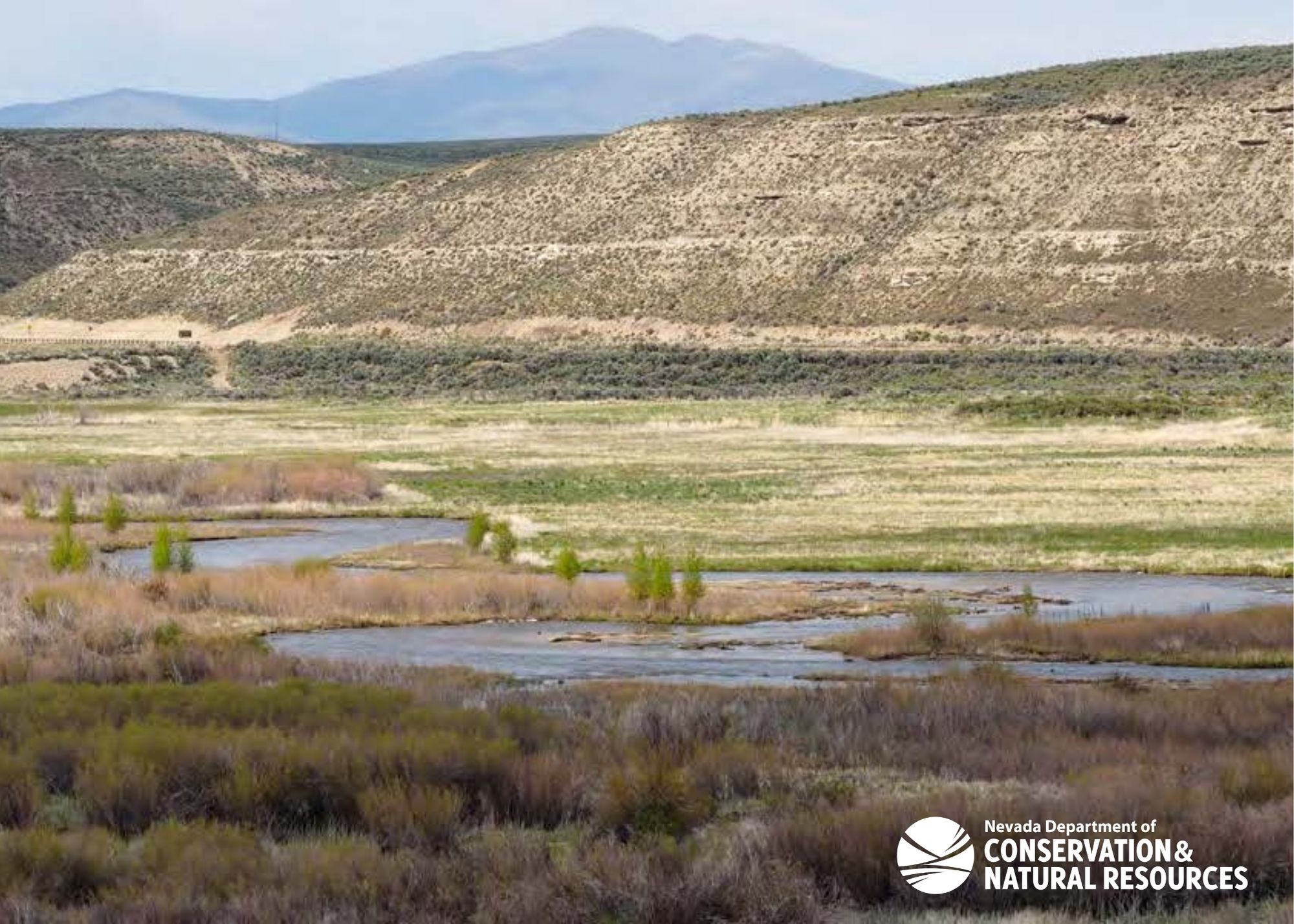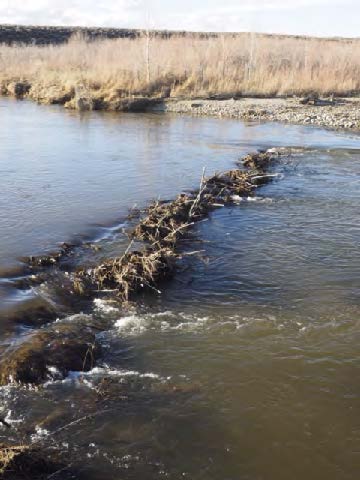South Fork River Stabilization and Meadow Restoration

Image: South Fork of the Humboldt River with narrow leaf cottonwoods established from Phase I of the 319h project
In December of 2019, the Nevada Division of Forestry (NDF) concluded the seven year long, multi-phased South Fork River Stabilization and Meadow Rehabilitation Project, funded by the Nevada Division of Environmental Protection (NDEP) 319(h) Nonpoint Source Grant Program, with significant matching funds from local and state partnerships. The project aimed to improve water quality issues on 566 acres along three miles of the South Fork Humboldt River and the South Fork Reservoir, within the South Fork State Recreation Area in Elko County, Nevada. Initially funded in 2013, Phase 1 included three seasons of field work focusing on invasive weed treatments within the most impacted meadow areas upstream of the South Fork Reservoir. In 2016, NDF was awarded Phase II funding to commence and expand the project goals. Between Phase 1 and Phase II, a total of $82,688 NDEP 319(h) funds were utilized, and $159,419 matching funds were acquired to accomplish the project goals. Matching funds and in-kind contributors from project partners included: Nevada Division of State Parks, Humboldt Watershed Cooperative Weed Management Area, Nevada Department of Agriculture, Nevada Gold Mines (Barrick Gold), Owyhee Conservation District, Rotary Club of Elko Desert Sunrise, Nevada Outdoor School, and NDF Seasonal Firefighters.

Image: South Fork River Stabilization and Meadow Rehabilitation Project Area Map
The primary goal of the project was to improve water quality entering and leaving the reservoir which outlets and enters the Humboldt River. The Humboldt River is listed as an impaired waterbody under the Clean Water Act Section 303(d). The primary nonpoint source pollutants impacting the project area were identified as sediment from streambank erosion and extensive sheet and rill erosion from abandoned farmlands infested with noxious weeds. In addition, the project identified an opportunity to indirectly mitigate high iron levels in the main stem of the Humboldt River, which is the parameter resulting in the river to be listed as a 303(d) impaired waterbody. To improve water quality issues, the project objectives focused on the following goals:
- Control noxious and invasive weeds which had invaded abandoned irrigated hay meadows since the time of state land acquisition in 1987.
- Reduce erosion in denuded lands by reseeding the meadows with native and introduced grasses.
- Reduce streambank erosion by increasing wood vegetation with cottonwood trees and sagebrush plantings.
- Augment beaver dams along the river by providing beavers adequate dam construction material.
- Monitor, manage, and maintain the treatment areas for goal attainment and maintenance needs.
The primary management techniques in which these goals were attained included the following: multi specie broadcast and seed drilling; riparian restoration through planting of trees and large shrubs (cottonwood, willows) in protective cages; caching (stockpiling) aspen cuttings to provide beavers adequate dam construction material; various herbicide application techniques, mechanical weed management, soil health management practices, and photo monitoring of vegetation establishment.

Image: Aspen branches from the cache, showing up in a new beaver dam.
Matching funds and labor support from a wide variety of community organizations and volunteer groups helped ensure success of these management techniques. The expansive partnerships established during this project allowed for a broader ecosystem-wide remediation and restoration project than 319(h) funding alone could provide. Additional management techniques evolved during the project as a result of strong partnerships, including soil testing, soil health improvement through organic fertilization, shrub plantings, sagebrush carcass caching, equipment repair and replacement, and increased soil erosion control.
By leveraging 319(h) grant funds with significant matching funds, the project capitalized on the opportunity to test and demonstrate a variety of experimental conservation practices to insure and enhance the grant deliverables by increasing beneficial vegetation, reducing erosion, restoring soil fertility, and potentially raising water tables. The project evolved into a Nevada Division of Forestry demonstration restoration area.
For example, remediating poor soil health became an adaptive management strategy necessary to reseed poor-denuded and barren soil. In addition, funds were utilized to experimentally encourage beaver dam establishment, by supplementing aspen tree branches necessary for beaver dam construction. Woody material for potential beaver dam building was limited in the project area, so the project team developed a strategy to cache aspen branches from an offsite fuel reduction project to provide beavers adequate stock material for dam construction. Lastly, sagebrush laden with seed was cut and cached onto nearby barren soils to hasten succession to a shrub steppe community, thought to exist on the uplands prior to being cleared for agriculture.
Positive Project Outcomes
Despite many challenges encountered throughout the project duration, including equipment failures, lapses in labor, flooding and erosional events to name a few, the project team successfully achieved the project goals. Persistent hard work season after season resulted in many positive outcomes, with additional outcomes unrelated to the scope of work supported by 319(h) grant funding. For example, the meadows and wetlands on the South Fork River become a demonstration area to train people in resource management and wetland restoration techniques. The project also addressed multiple environmental restoration needs for this heavily used unit of the Nevada State Parks system and provided public education opportunities. Among those benefitting, Nevada Outdoor School youth groups tended to tree and shrub restoration plantings. An NDF intern gained experience in herbicide application, photo monitoring, vegetation restoration maintenance. NDF seasonal firefighters gained experience in conservation practices, spraying fertilizers, operation of rangeland drills and tractors, and inmate crews gained experience in various conservation practices.

Image: Volunteers planting 30 trees and installing protective cages.
Project Conclusion: While there remain challenging areas with incomplete weed control and sparse ground cover, the majority of the 566-acre project restoration site has been deemed a success by project collaborators. It serves as a testament to how adaptive management can keep a project moving forward through periods of bad weather, flooding, equipment breakdowns, personnel shortages, and at times fiscal challenges. The project is considered a successful model of collaborations among state government agencies, non-profit conservation organizations and business, especially through mining company grants addressing social responsibility commitments to the communities they reside in.
With federal, state and community support, the Meadows and the southern shores of South Fork Reservoir have become a prominent example of a successful 319(h) funded project resulting in a reduction of nonpoint source pollutants and increased environmental conservation. The project is also a great example of successful interdivisional collaboration within three large divisions of the Nevada Department of Conservation and Natural Resources - Division of Forestry, Division of State Parks, and Division of Environmental Protection. Furthermore, at a time when the COVID-19 pandemic has brought more demand for public recreation opportunities, the Meadows are enjoying frequent use by the public seeking outdoor recreation and while providing enhanced habitat for wildlife.
The Nevada Division of Environmental Protection (NDEP) 319(h) Nonpoint Source Grant Program provides funding to qualifying counties, conservation districts, higher education institutions, regional agencies, and nonprofit organizations to improve conditions of Nevada’s watersheds and protect against nonpoint source (NPS) water pollution. Nonpoint Source Grant Program funds originate from a US Environmental Protection Agency grant pursuant to the federal Clean Water Act (CWA) To learn more about the 319(h) grant program please click here.
